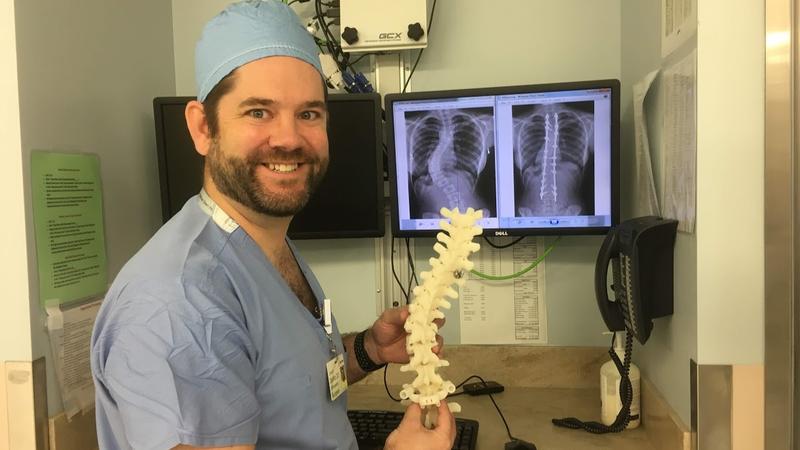
Dr. Joseph DeWitt holds a model of patient Jacie Rish's spine in front of X-rays taken before and after her surgery.
Sparrow Hospital in Lansing is employing new technology aimed at improving the outcomes of patients undergoing surgery for scoliosis. 3D modeling might lead to better results.
VIDEO LINK : https://youtu.be/60LTnPw07IA
Scoliosis is a sideways curvature of the spine that usually occurs before puberty. Most cases are mild, but some children develop deformities that get worse as they grow.
Sparrow Hospital in Lansing is employing new technology aimed at improving the outcomes of patients undergoing surgery for scoliosis. 3D modeling might lead to better results.
VIDEO LINK : https://youtu.be/60LTnPw07IA
Scoliosis is a sideways curvature of the spine that usually occurs before puberty. Most cases are mild, but some children develop deformities that get worse as they grow.
Sparrow Hospital recently invited reporters into a surgical suite to learn more about scoliosis from pediatric orthopedic surgeon Dr. Joseph DeWitt. He says the causes are largely unknown. “When kids are getting towards puberty and growing really fast, that’s when they’re at the greatest risk for scoliosis, and for scoliosis to progress and get worse," he explains. "That’s when we like to intervene and take care of them.”
Dr. DeWitt says that while many patients are helped by bracing the spine, bracing alone isn’t enough in more severe cases. “Sometimes you get in situations where the curve’s gotten big, up over 45 to 50 degrees," continues Dr. DeWitt. "Those curves, even when you’re done growing, those are going to continue to get worse later in life, and that can become deforming and that can start to interfere with the way you want to live your life. Those are the kids that we think are candidates for surgery.”
One such patient was Jacie Rish of Portland. Last year, when she was 14, her spine was curved by more than 65 degrees. “My mom noticed that my back looked a little funny," Jacie states. "It didn’t look right. It was like my body, my hips were crooked. You could really see it.”
With a decision made to perform surgery on Jacie, Dr. DeWitt turned to new 3D technology to make a model of her spine. “We take a CT scan, we’re able to load that CT scan into the computer, 3D model it, and then at every level that we determine that we need to fuse, we’re able to create a patient-specific guide for that level," he continues. "This allows us to very, very accurately and safely place our hardware, which consists primarily of screws, a couple of hooks, and then rods.”
With that model, guides are created to help the surgeon precisely insert the hardware that will address the curvature.
Jacie’s surgery took about eight hours, involving 18 screws, two hooks and two rods from neck to hip level. That hardware will remain attached to her spine for life.
Jacie’s mom, Lisa, says her daughter spent four days in the hospital after the operation. “She was off school for probably another three, almost four weeks," Lisa says. "She couldn’t carry anything over five to ten pounds. It was just a lot of modifications into how she had to bend down to pick stuff up, she couldn’t move side to side, so we had some help at school with schoolbooks and backpacks. It was a long recovery time, but we’re about a year out.”
Jacie adds that she doesn’t even notice it anymore.
With her curvature down from 65 degrees to 19 now, there are no restrictions on Jacie’s future activity, and Dr. DeWitt is optimistic about her future. He's done about 20 surgeries using this 3D modeling technology, and he isn’t looking back.
Source : WKAR , 20 AUG 2018
Source : WKAR , 20 AUG 2018

No comments:
Post a Comment